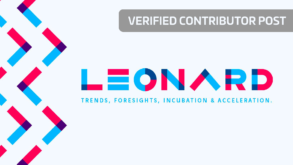 This article was contributed by Leonard by VINCI as part of the BuiltWorlds Verified Contributor Program.
This article was contributed by Leonard by VINCI as part of the BuiltWorlds Verified Contributor Program.
Fondations is the Leonard podcast that opens the doors to the city of tomorrow. Every two weeks, you can hear from the entrepreneurs who are transforming mobility, construction, real estate and energy. In this third episode, we welcome Heidi Lehmann, COO of Kenzen. This start-up based in the San Francisco Bay Area has developed a new physiological monitoring platform. Its purpose: to protect workers from accidents caused by heat.
Listen for free to the third episode of Foundations, a Leonard podcast.
How can companies ensure the safety of their teams in the field? How can workers detect accidents before they happen? Before a heat stroke, sunstroke or dehydration, our bodies send out warning signals: dizziness, sweats, rising body temperature…
Teams of scientists, engineers and experts in mobile technologies and connected objects from the American start-up Kenzen offer to monitor these indicators.
Ensuring the Health and Safety of Workers Using Algorithms and Sensors
Here’s how it works: workers are equipped with a patch connected to the cloud, which transmits their data in real time. The patch is worn on the arm and collects data every 5 seconds: heart activity, body temperature, etc. If the signals indicate any cause for concern, an alert is sent to the team safety manager, who can then make sure the worker hydrates, rests in the shade for a few minutes or, if the case is more serious, receives medical attention.
1.3 million data bytes collected every day
“Our mission is to keep workers safe and healthy”
– Heidi Lehmann, Chief Commercial Officer, Kenzen
Kenzen has already completed several pilot projects, including one in Japan in the renewable energy sector. “Japan has very hot and humid summers“, explains Heidi Lehmann. “The company we worked with had already experienced cases of heat stroke, at least one of which was fatal. Knowing when to take a break was therefore essential“.
“Confidentiality is extremely important to us”
– Heidi Lehmann, Chief Commercial Officer, Kenzen
The platform is aimed at three different types of users. All of them have access to different sets of data, governed by the corresponding confidentiality terms:
- Workers can track their data in real time and access their history.
- Safety managers receive alerts when a worker is at risk, and they can then intervene by asking the worker to get some shade or hydrate. However, they have no access at all to workers’ health information.
- Management has access to an anonymized version of the data, which allows them to understand and analyze trends and thus make workplaces safer.
Everything Started with Football Players
Before deciding to invest in construction sites and factories, Kenzen was interested in sports, and more particularly in American football, with the San Francisco 49ers. “Professional athletes are surrounded by coaches and a lot of money is spent to keep them in very good health“, notes Heidi Lehmann. “In this context, our platform was more of an optimization tool“.
Some of the Kenzen co-founders started their careers in Chinese factories, where heat is a major health problem. It all happened very quickly: “We realized that what we had tested in the sports world could make a real difference in the industrial sector“.
“We are very ambitious.”
– Heidi Lehmann, Chief Commercial Officer, Kenzen
Improvements are made to the platform on an ongoing basis. “Originally, our patch was designed to be worn on the chest“, says the COO. “We have a lot of women on our team, so we didn’t anticipate that this could be painful for men with hairy chests!”
What’s next on the start-up’s roadmap: improving the battery, adding more miniaturization… And exploring the potential to address issues other than heat. “We started with heat, because that’s the main concern we identified. But we’re also interested in fatigue, overwork and even cold. And, in the context of Covid-19, we are also looking at how we can detect fever.”
This article was contributed by Leonard by VINCI as part of the BuiltWorlds Verified Contributor Program.



Discussion
Be the first to leave a comment.
You must be a member of the BuiltWorlds community to join the discussion.